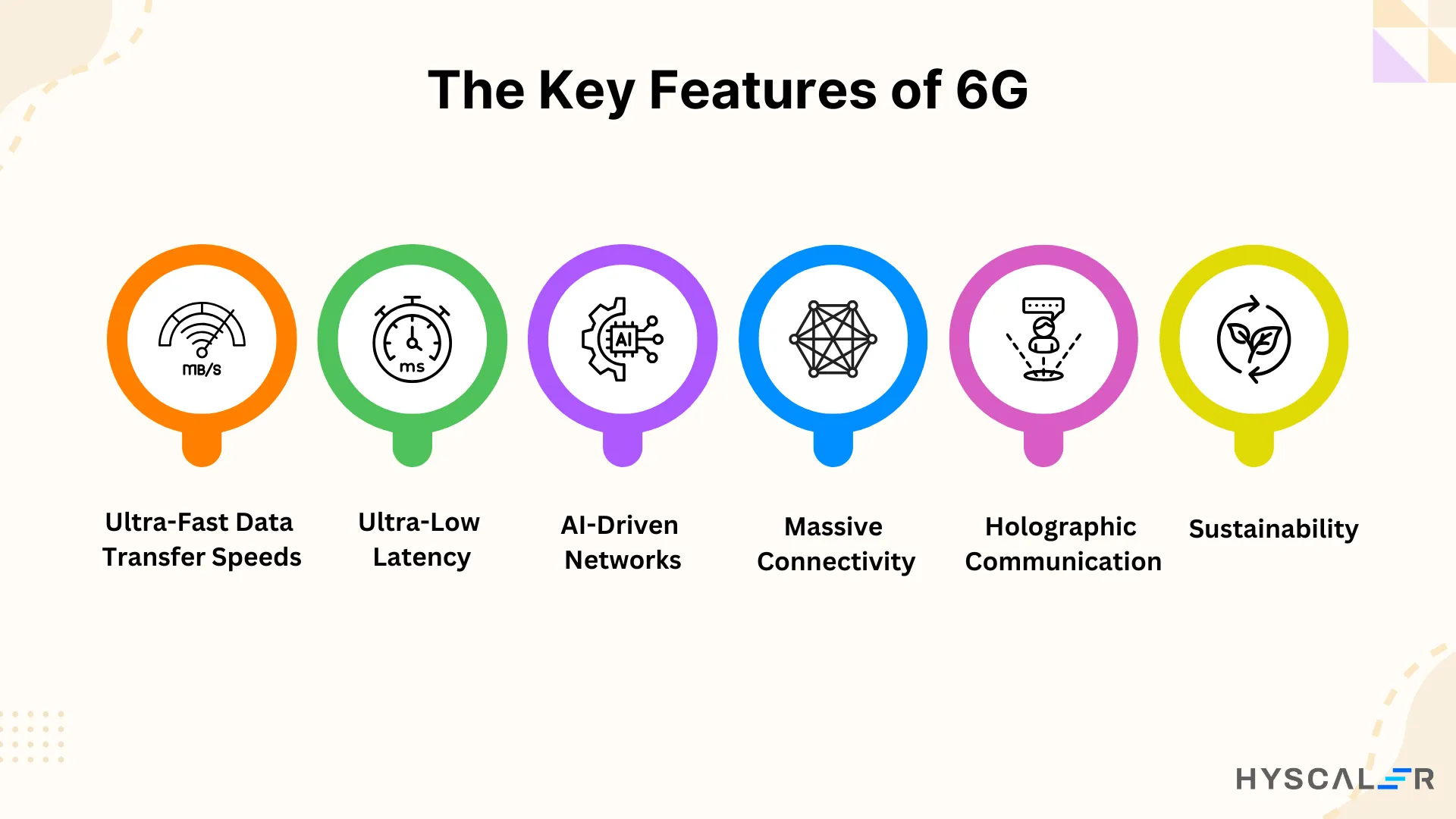Table of Contents
As we continue to witness rapid advancements in technology, 6G promises to be an exciting area on the horizon. Although the world is still in the process of rolling out the 5G networks, researchers and technologists are already looking beyond to the next generation of wireless connectivity. This will likely prompt transformational capabilities that will radically change the way we live, work, and interact with the world around us, and it is expected to be rolled out commercially sometime in the 2030s.
Recent research carried out by Ericsson suggests that 6G networks are likely to attain data speeds of up to 1 terabit per second (Tbps), thus boosting the data rates by a factor of 100 per due process norm used at a one-time peak speed of 5G. Such high speed, along with ultra-low latency, would then lead to reshaping applications in healthcare, entertainment, transport, and beyond.
A MarketsandMarkets report indicates that the global market for 6G technology may surpass $200 billion by 2030. Essentially, this illustrates the massive opportunity for innovation and business growth. This article explores the key features, potential applications, and challenges of 6G, as well as how it will shape the future of connectivity.
What is 6G?
Sixth-generation wireless technology, or 6G, offers much more than just faster speeds and better coverage. Although 5G has the potential for speeds up to 10 Gbps, the 6th Generation may already go all the way beyond that, up to 100 times faster, at terabit-per-second levels.
This jump will allow next-generation applications such as real-time holographic telecommunication and artificial intelligence (AI)–powered agent systems.
With latencies as low as 1 ms, it will provide imperceptible, ultra-reliable connectivity, enabling new applications such as smart cities, immersive AR/VR, and a world of connected things.
The Key Features of 6G
- Ultra-Fast Data Transfer Speeds: The most promising aspect of 6G is its unprecedented data speed. Another expectation is that it should be 10fold faster than 5G and it will support real-time communications for, for example, augmented reality (AR) and virtual reality (VR), which will provide a natural and unobtrusive user experience. This will revolutionize the work fields of telepresence, education, and entertainment.
- Ultra-Low Latency: Using latency as low as 1 ms, future connectivity will allow near real-time communication. This is critical to autonomous vehicles, smart cities, and telemedicine, among others, for which real-time data streaming is necessary.
- AI-Driven Networks: Artificial intelligence (AI) will also be critical in the optimization of network management, connectivity, and resource use. Through the effective management of data flows, failure prediction, and the enabling of autonomous systems such as self-driving vehicles, AI will lead to smoother and more intelligent workflows.
- Massive Connectivity: As the Internet of Things (IoT) continues to expand, the next generation of networks will facilitate a seamless connection between billions of devices. From wearables and domestic appliances to industrial robots and medical devices, this connectivity will open communication potential in a wide range of fields.
- Holographic Communication: One of the most futuristic aspects of the technology is its capability for holographic communication (i.e., real-time 3D interaction). From using holographic virtual meetings to working with 3D models of human faces, this may alter how we communicate and work together.
- Sustainability: 6G will prioritize energy efficiency and eco-friendly design. Using advanced energy management and green technologies it strives to minimize the carbon footprint of wireless networks, in support of a more sustainable world of global connectivity.

Unlocking the Future: Game-Changing Applications of 6G
- Autonomous Systems: The next generation of connectivity will play a key role in the evolution of autonomous vehicles, unmanned aerial vehicles (drones), and robots. Communications with vehicles in real-time with vehicle environment and other vehicles via low latency and high-speed data exchange will be realized. Instant decision-making, better traffic movement, and safety will be obtainable. By 2030, $60 billion in value will be attributed to autonomous vehicle adoption, showing the great promise of 6G-driven automation.
- Smart Cities: 6G will be the revolution in intelligent cities, such that it will be possible to smoothly bring together the different infrastructures. From traffic lights to waste management systems, everything will be connected and optimized in real-time. This will lead to savings of energy and money, improvements in performance and quality of life. According to MarketsandMarkets, the smart city market will grow to $717.2 billion by 2025, mainly due to 6G connectivity developments.
- Healthcare Revolution: The high speed and the low latency of 6G will change the way medicine works and will transform healthcare with real-time telemedicine surgery, accurate remote medical images, and real-time patient vitals tracking through wearable devices. This will lead not only down the path of making telemedicine more affordable and practical but also a step further in telemedicine forward, with greater scope to reach those areas that are without access. A McKinsey report shows that connected healthcare has the potential to save the global health system over $300 billion per year by 2025.
- Immersive Experiences: Augmented and virtual reality will flourish in a 6G-powered society with high-resolution ultra-visual content and real-time interaction. This will transform industries including gaming, entertainment, education, and training by delivering complete immersive digital worlds. The AR/VR market is expected to surpass $300 billion by 2024, with 6G providing the necessary infrastructure to support this growth.
- AI and Machine Learning Integration: Deep integration of AI and 6G will enable more effective data prediction, traffic control, and device communication. This will lead to further automation in its industries, by maximizing processes and increasing operational efficiency. Gartner research indicates that by 2030 AI-powered automation could add $15.7 trillion to the global GDP, thus highlighting the disruptive potential of 6G-powered AI.
From Vision to Reality: Overcoming Obstacles in 6G Evolution
Infrastructure Demands: Building the Backbone of 6G
- Challenge: The even higher speeds and extremely low latency that 6G will offer will necessitate a new infrastructure altogether. This also covers next-generation antenna designs, satellite systems, and data centers that can manage huge volumes of information. The shift to this facility can be a very expensive and intricate step.
- Solution: Collaboration between private companies and government agencies will be crucial to building the necessary infrastructure. To maximize the current architecture, a new class of network-sharing models (e.g., edge computing) and novel solutions (e.g., edge computing) are emerging to facilitate a step-wise rollout of new technologies. According to industry projections, investment in 6G infrastructure could exceed $200 billion by 2030, driving innovations in network design and deployment.
Spectrum Allocation: Securing the Airwaves
- Challenge: For its high data rate, 6G will have to operate in bands that have never been used before. This poses a problem of spectrum identification and interference with active networks, especially where the population is high in dense urban areas.
- Solution: Governments, regulatory bodies, and the like, the International Telecommunication Union (ITU), for instance, are beginning to schedule new band frequencies for 6G. To solve this allocation problem dynamic spectrum sharing as well as new antenna technology might have a large impact on improving the utilization of the available airwaves to minimize interferences and maximize bandwidth use.
Cybersecurity Concerns: Safeguarding the Digital Frontier
- Challenge: As connected devices increase in number and artificial intelligence (AI) takes part in network management, cybersecurity becomes a highly important issue. With the growing attack surface and the sensitivity of real-time transmitted data for autonomous systems, medical data, and critical infrastructure it will be more difficult than ever to secure their integrity of them.
- Solution: The research and development into the area of quantum communication, artificial intelligence-based security threat detection, and blockchain-based secured data exchange will play a key function in enhancing the security of 6G networks. Moreover, the cybersecurity market will amount to 44 billion dollars by 2025, enriching the necessity of the creation of innovative security solutions to respond to the needs of a hyper-connected world.
Ethical Considerations: Balancing Innovation with Responsibility
- Challenge: When 6G technologies, such as holographic communication and AI-based decision-making become a reality, ethical challenges related to the issue of privacy, data ownership, and digital inclusion will surface. The vast amount of personal and sensitive data transmitted across 6G networks raises questions about who controls and owns this information.
- Solution: A clear regulatory environment for data privacy and just access, however, will be very important. Coordinated efforts to and among governments, technology companies, and ethical institutions will enable the development of transparent rules that safeguard individuals’ entitlements and encourage technological change. Ethical concerns and data sovereignty will influence the deployment of 6G and, thus, will ensure that progress and responsibilities are confronted equitably.
Final Insights

6G is more than just an upgrade on 5G, it promises to change the digital landscape entirely. Thinking back to some of the anticipated applications of the technology—from autonomous vehicles to smart cities to virtual and augmented realities—6G holds the promise of transforming industries.
On the road to realization, 6G is guaranteed to deepen unprecedented connectivity, which in turn would yield impactful innovations across healthcare, education, entertainment, and more. For now, we find ourselves at the beginning, and the possibilities are endless; the long-term impact on economies, societies, and global industries will be hard to fathom. The journey to 6G is seen as the frontier of digital transformation.
The projected sales growth chart highlights the transformative potential of this technology over the coming years. Starting from modest beginnings in 2020, the growth accelerates significantly from 2024 onward, with sales expected to reach $10 million by 2028.
This trajectory underscores the rapid adoption and integration of the 6th Generation technology across industries, driven by its unparalleled speed, low latency, and potential to revolutionize connectivity. Start evaluating how 6G could reinvent your business and industry. Get ahead—embrace tomorrow’s connectivity today!
READ MORE:
HR Performance Excellence: Unlock Potential with Visual Planning
Ground Breaking Power of AI-Driven Climate Models in Disaster Prevention